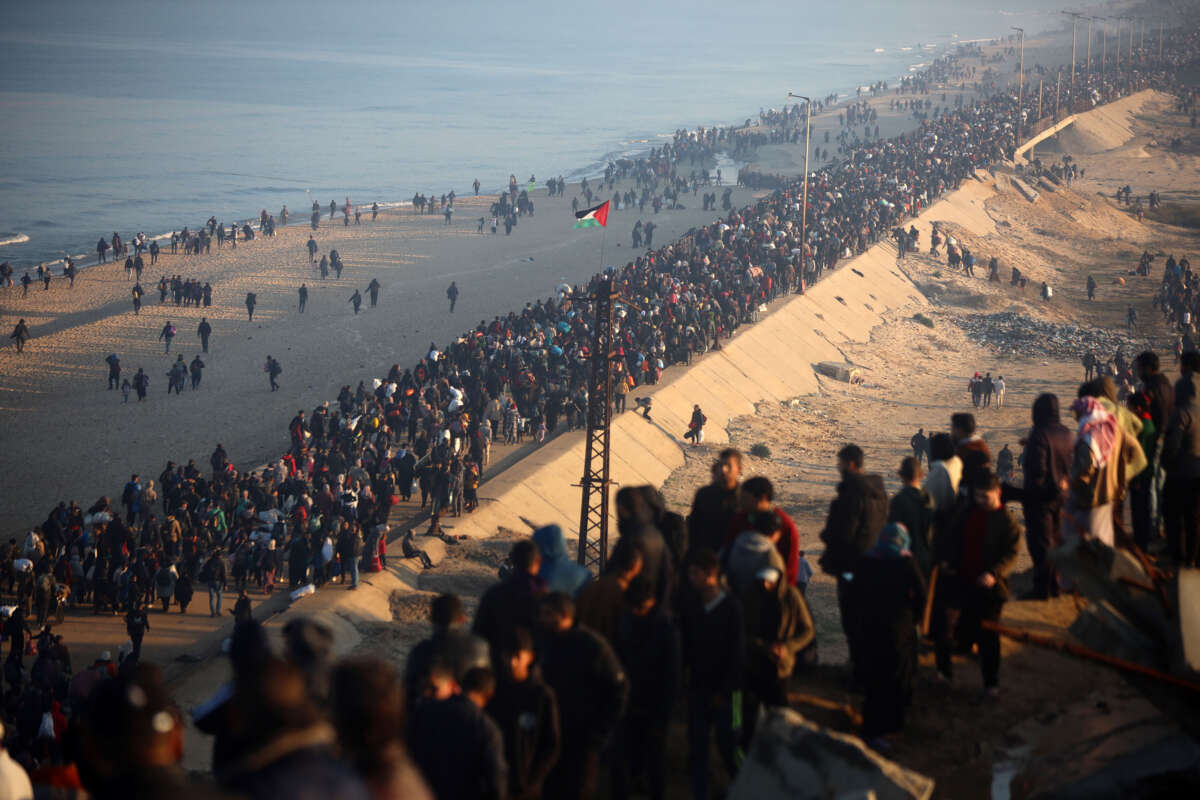On Monday, hundreds of thousands of Palestinians reunited and reached their neighborhoods in northern Gaza for the first time in over 15 months of genocide.
Videos and pictures showed scenes of joy and jubilation as Palestinians crossed the Netzarim Corridor, an area of Gaza which Israeli forces had occupied to divide the besieged Palestinian territory in half amid the genocide while turning it into a kill zone. Israeli forces had announced that it would allow Palestinians to return by foot and by car on Monday morning.
Palestinians are celebrating the return to the region as a major milestone. Videos showed Palestinians singing and playing music as they walked north, carrying their few belongings in plastic or burlap bags.
Many Palestinians vowed to rebuild their homes and neighborhoods as many returned to areas completely reduced to rubble.
“We saw a change in the mood of everyone. We have never seen people that happy in the past 15 months,” Al Jazeera journalist Hani Mahmoud reported. “People describe this moment as historic. They say it’s as important as the announcement of a ceasefire. For them, this is a victorious day.”
“It’s the joy of return,” Abu Matter told the Associated Press. Matter’s family was among the 700,000 Palestinians driven from their homes as part of the 1948 Nakba, which led to the establishment of Israel. “We had thought we wouldn’t return, like our ancestors.”
Palestinian journalists like Hossam Shabat and Anas Al-Sharif shared videos of themselves emotionally reuniting with friends and family who were forcibly displaced by Israeli forces. Journalist Muhammad Shehada said that the return to north Gaza was “Gaza’s Berlin Wall moment.”
The corridor was supposed to be opened over the weekend, but Israeli forces delayed its opening, citing a dispute with Hams over the release of an Israeli captive, Arbel Yehud, during the prisoner exchange on Saturday.
Israeli forces shot at and killed at least two Palestinians who were trying to return to north Gaza on Sunday. Palestinians had gathered in a huge crowd near the corridor over the weekend, waiting for it to open.
On Saturday, Hamas released four Israeli soldiers who had been held in Gaza, while Israeli forces released 200 Palestinians held in Israel’s torture camps and prisons.
Hamas said that Israeli forces violated the terms of the ceasefire agreement by delaying the opening of the corridor. The political organization said that the return of Palestinians to northern Gaza was a victory for the Palestinian people.
Israeli National Security Minister Itamar Ben-Gvir condemned the opening of the corridor, and said it was akin to “complete surrender” to Hamas by allowing Palestinians to return to their homes. In recent months, Israeli forces had been carrying out an all-out siege of northern Gaza, which appeared to have the goal of driving out Palestinians from the region through forced evacuations, starvation or killings, according to human rights advocates.
Even as Palestinians return, the hazards remain. Gaza journalist Motasem A. Dalloul reported that children were injured after the detonation of an unexploded Israeli bomb in Khan Younis. The UN has warned that the humanitarian aid operations will greatly suffer if Israel’s ban on the UN Relief and Works Agency for Palestine Refugees (UNRWA) goes into effect on Tuesday, which will leave millions of Palestinians without food, health care or other basic necessities.
Angry, shocked, overwhelmed? Take action: Support independent media.
We’ve borne witness to a chaotic first few months in Trump’s presidency.
Over the last months, each executive order has delivered shock and bewilderment — a core part of a strategy to make the right-wing turn feel inevitable and overwhelming. But, as organizer Sandra Avalos implored us to remember in Truthout last November, “Together, we are more powerful than Trump.”
Indeed, the Trump administration is pushing through executive orders, but — as we’ve reported at Truthout — many are in legal limbo and face court challenges from unions and civil rights groups. Efforts to quash anti-racist teaching and DEI programs are stalled by education faculty, staff, and students refusing to comply. And communities across the country are coming together to raise the alarm on ICE raids, inform neighbors of their civil rights, and protect each other in moving shows of solidarity.
It will be a long fight ahead. And as nonprofit movement media, Truthout plans to be there documenting and uplifting resistance.
As we undertake this life-sustaining work, we appeal for your support. Please, if you find value in what we do, join our community of sustainers by making a monthly or one-time gift.
